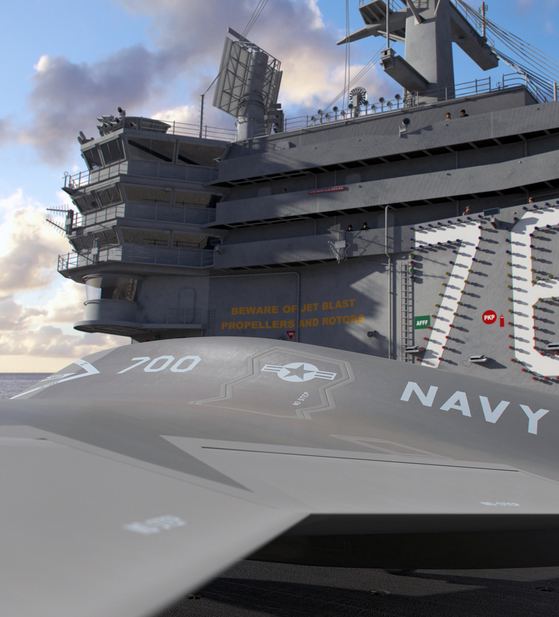 | ||
The Lockheed Martin Sea Ghost is a proposal to fulfill the United States Navy's requirement for a Unmanned Carrier-Launched Airborne Surveillance and Strike aircraft.
Contents
Design
The Sea Ghost incorporates technologies from the F-35C Lightning II and RQ-170 Sentinel UAV, both other Lockheed designs. It has a bat-wing fuselage and emissions and bandwidth management for multi-spectral stealth. Lockheed claims it can reduce manpower requirements because a single operator could be able to operate multiple aircraft. Lockheed had a full-scale mock-up of the design to look at fit checks when the pre-solicitation was issued. The flying wing design was chosen because it was well suited for the missions intended for the aircraft, and the company had experience with it. It is aerodynamically efficient, allows for very low signatures, is structurally simplistic, and is easy to manufacture. The Sea Ghost will use sea spray optimized stealth materials developed for the F-35. The Sea Ghost has range and endurance, but does not have the weapons payload capability of a long-range strike platform, such as the A-6 Intruder; making it carry large payloads at long ranges would affect affordability. It is made with open architecture avionics to have the ability to put new sensors or mission systems onboard over time. The Sea Ghost is made to operate autonomously, with the operator intervening if necessary.
The Sea Ghost is competing against the Northrop Grumman X-47B, the General Atomics Sea Avenger, and the Boeing Phantom Ray, or operational versions of those aircraft, in the program.
Lockheed Martin stresses the flying wing design of the Sea Ghost has the "inherent" stealth needed for the Navy to operate in future high-threat environments. They believe they have an advantage in that it is designed from the outset to be stealthy, and that the Navy has to “start out with the right shape of the aircraft” because capability improvements may not be viable if they don't. A Request for Proposals (RFP) released by the Navy for the UCLASS in early April 2014 calls for a strike and reconnaissance platform that will gain additional capabilities over time, including the ability to be refueled aerially, and to act as a tanker itself.
In early 2016, the UCLASS was changed into the Carrier Based Aerial Refueling System (CBARS), changing the focus from high-end strike to a more basic air vehicle functioning primarily as an aerial tanker. Although pursuing a more basic design could favor General Atomics and Boeing wing-body-tail submissions, Lockheed believes a flying wing could be affordable while allowing more room for growth. By selecting a basic flying wing design, weapons, sensors, and stealth could be more easily added to the existing airframe to allow it to penetrate into a contested environment.
History
On 14 August 2013, Lockheed Martin was awarded a $15 million contract to develop the airframe of their UCLASS entry. Contracts of the same amount were awarded to Boeing, General Atomics, and Northrop Grumman for their competing designs. A competition for a final airframe design was expected after January 2014.
